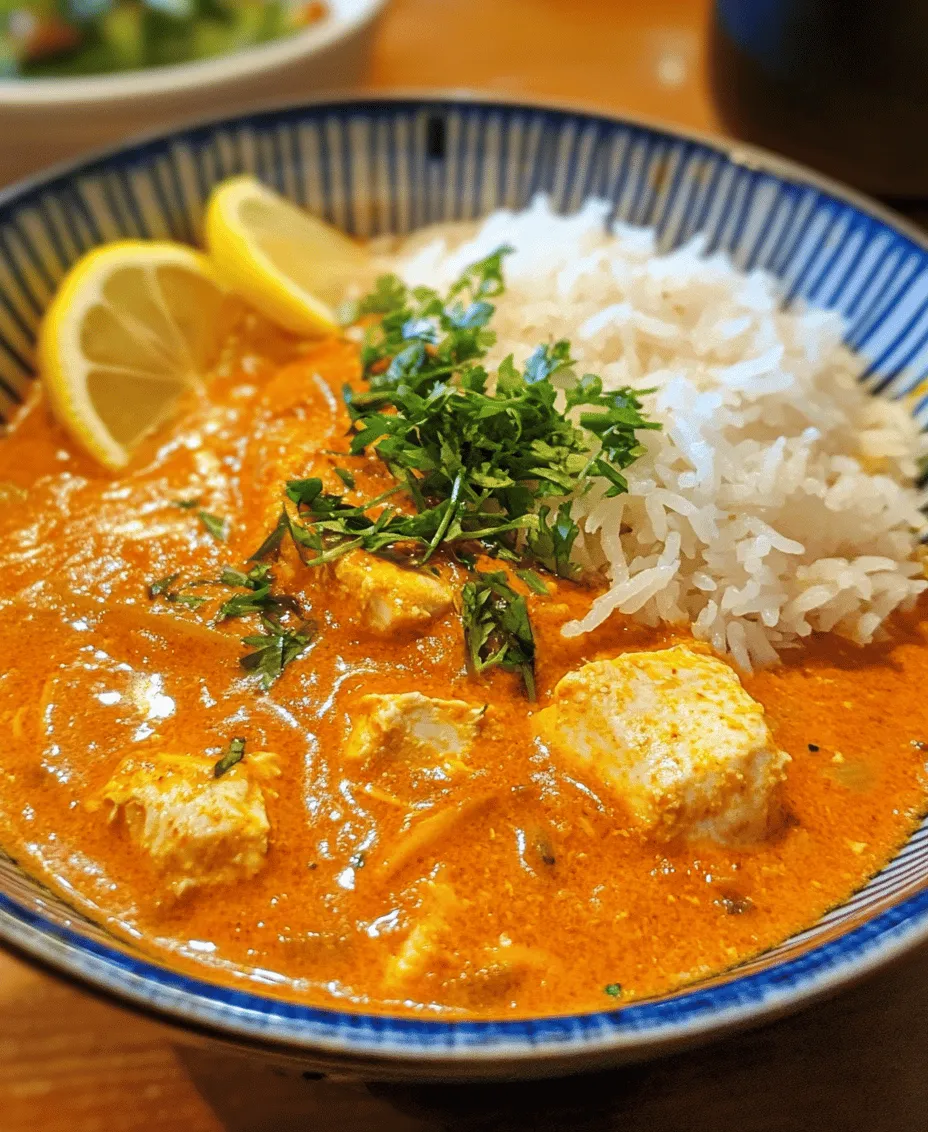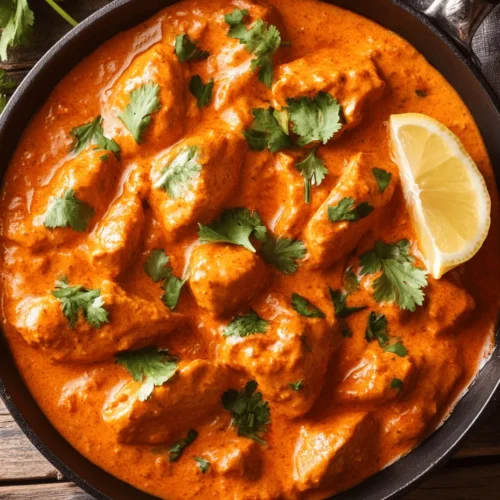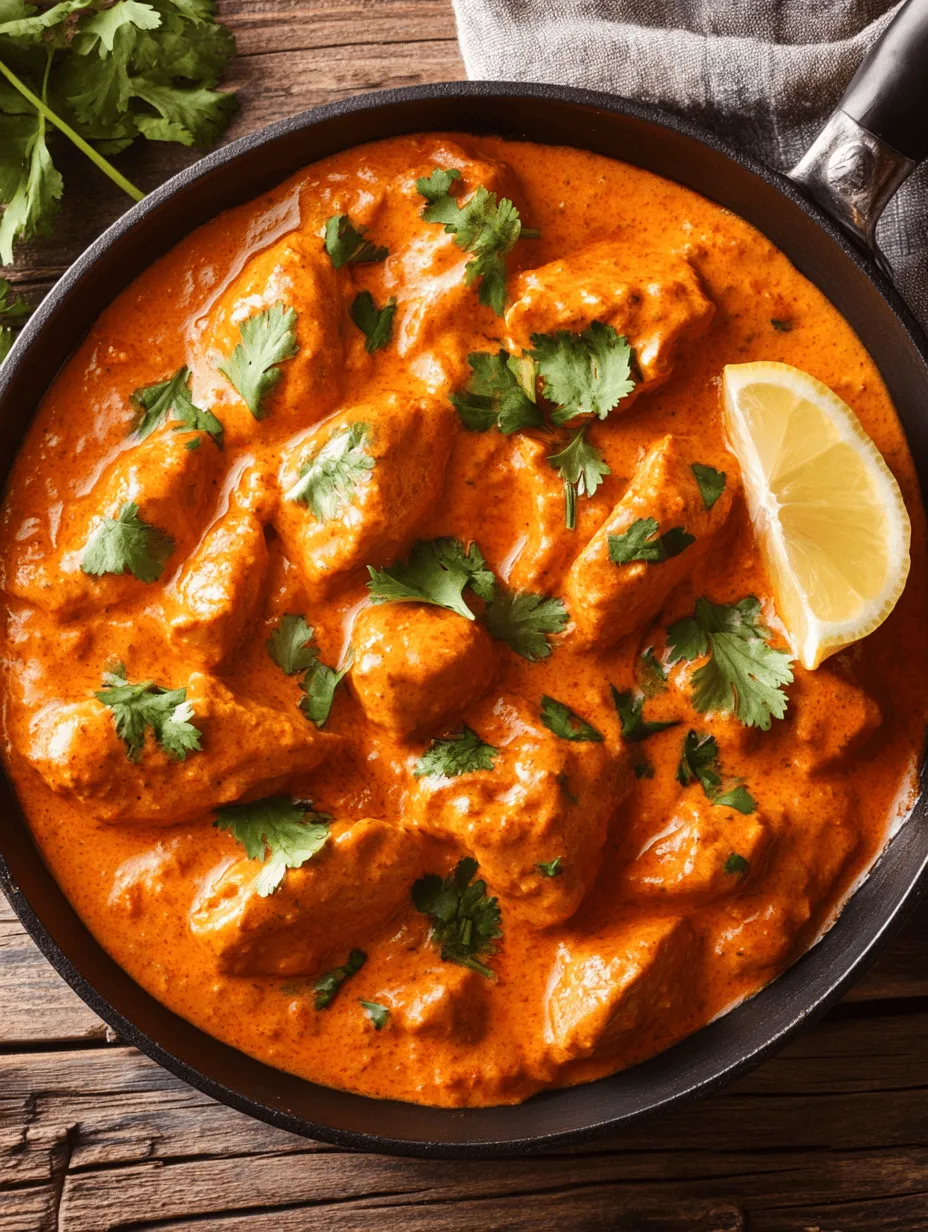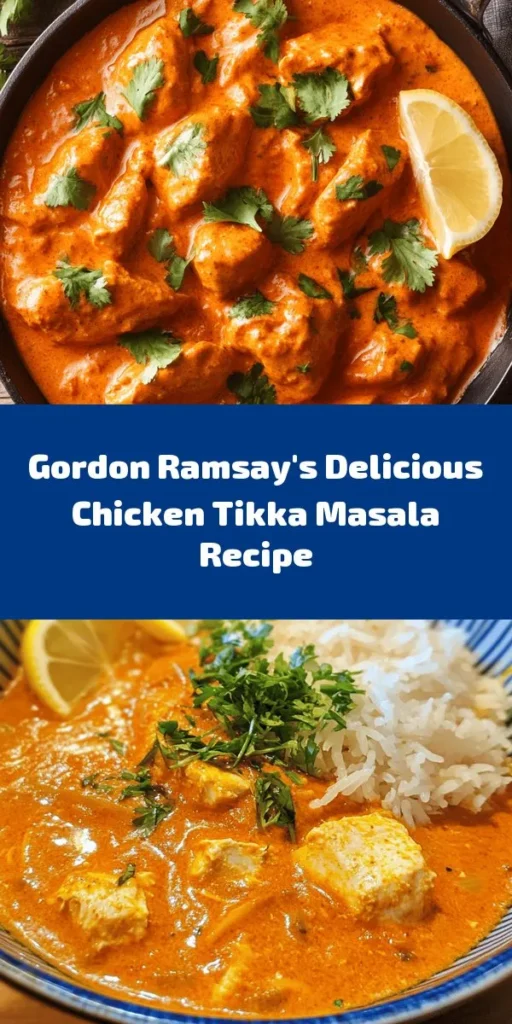Introduction
Gordon Ramsay’s Chicken Tikka Masala stands as a testament to the vibrant world of Indian cuisine, embodying a delightful harmony of flavors and textures that captivates the palate. This dish, known for its rich, creamy sauce and tender pieces of chicken, has transcended geographical boundaries to become a beloved staple in homes and restaurants worldwide. The alluring blend of aromatic spices and the comforting warmth of the dish make it not just a meal, but an experience that echoes the rich culinary heritage of India.
In this comprehensive guide, we will not only explore the step-by-step process for making Gordon Ramsay’s Chicken Tikka Masala but also delve into its cultural significance, variations, and tips for achieving that perfect balance of flavors that will elevate your culinary skills. Whether you’re a seasoned chef or a home cook looking to expand your repertoire, this guide will provide you with insights and techniques to master this iconic dish.
Understanding Chicken Tikka Masala
Exploring the Origins of Chicken Tikka Masala
The origins of Chicken Tikka Masala are as rich and complex as the dish itself. While it is widely celebrated as a staple of Indian cuisine, the exact roots of Chicken Tikka Masala are a matter of debate. Many food historians trace its beginnings to the Indian subcontinent, where marinated chicken is traditionally grilled in a tandoor oven. This method of cooking imparts a unique flavor, setting the stage for what would eventually evolve into the creamy, spiced dish we know today.
However, the dish is also often claimed by the United Kingdom, where it gained immense popularity in the 1960s and 1970s. The story goes that a British customer, dissatisfied with the dryness of his tandoori chicken, requested a sauce to accompany his meal. In response, a clever chef whipped up a spiced tomato-based sauce, thus giving birth to the Chicken Tikka Masala we enjoy today. This cross-cultural culinary fusion reflects the adaptability and creativity of Indian cuisine, highlighting its ability to evolve and resonate with diverse palates.
Importance of Chicken Tikka Masala in Modern Cuisine
Today, Chicken Tikka Masala holds a cherished place in modern cuisine, not only as a restaurant favorite but also as a beloved dish in home cooking. Its widespread popularity has led to it being dubbed one of the UK’s national dishes, symbolizing the integration of Indian culinary traditions into British culture. The dish has become a beacon of culinary fusion, representing how food can bridge cultural divides and bring people together.
In restaurants, Chicken Tikka Masala is often featured as a highlight on Indian menus, showcasing the richness of Indian flavors while appealing to the tastes of a broad audience. Its creamy texture and aromatic spices have made it a favorite for families and individuals alike, who appreciate its comforting qualities and the ease with which it can be prepared. As more people seek to recreate restaurant-quality meals at home, Chicken Tikka Masala stands out as an approachable yet impressive dish that showcases the art of cooking with spices.
Ingredients Breakdown
To embark on the journey of making Gordon Ramsay’s Chicken Tikka Masala, it is essential to gather the right ingredients. Each component plays a crucial role in developing the dish’s signature flavor profile. Below, we break down the essential ingredients that will elevate your Chicken Tikka Masala from ordinary to extraordinary.
Essential Ingredients for Gordon Ramsay’s Recipe
Chicken: Choosing the Best Cuts and Preparation Methods
The foundation of any great Chicken Tikka Masala is, of course, the chicken. For this recipe, boneless chicken thighs are recommended due to their rich flavor and moist texture. Unlike chicken breasts, which can dry out during cooking, thighs remain juicy and tender, absorbing the marinade beautifully. When selecting chicken, opt for high-quality, fresh meat to ensure the best results.
Before marination, it is crucial to cut the chicken into uniform pieces. This ensures even cooking and allows the marinade to penetrate the meat effectively. Depending on your preference, you can also use chicken breasts, but ensure they are not overcooked to maintain tenderness.
Yogurt: Role in Marination and Flavor Enhancement
Yogurt is one of the key ingredients in the marinade for Chicken Tikka Masala. It serves several purposes: not only does it tenderize the chicken, but it also adds a subtle tang that balances the dish’s richness. The lactic acid in yogurt breaks down the proteins in the chicken, resulting in a more tender texture.
For the best flavor, use plain, unsweetened yogurt. Greek yogurt is a great option, as its thickness helps create a luxurious marinade. Marinating the chicken in yogurt for several hours or overnight allows the flavors to infuse deeply, enhancing the overall taste of the dish.
Tikka Masala Paste: Understanding Its Components
The heart of Chicken Tikka Masala lies in the tikka masala paste. This spice blend typically includes a combination of ground spices such as cumin, coriander, turmeric, and garam masala, along with fresh ingredients like garlic, ginger, and green chilies. The paste not only imparts a robust flavor but also gives the dish its characteristic vibrant color.
Gordon Ramsay’s recipe may call for a premade tikka masala paste, which can be conveniently found in grocery stores. However, for those who wish to create their own, a simple blend of the aforementioned spices along with some tomato puree and cream can yield an authentic and flavor-packed paste.
Aromatics: The Importance of Onion, Garlic, and Ginger
Aromatic ingredients like onions, garlic, and ginger form the backbone of the Chicken Tikka Masala sauce. Onions provide a sweet and savory base, while garlic and ginger introduce warmth and depth. Finely chopping or grating these ingredients ensures they cook evenly and meld into the sauce seamlessly.
When preparing the sauce, it is essential to cook the onions until they are soft and golden brown, as this caramelization enhances their natural sweetness and contributes to the overall flavor profile of the dish. The combination of these aromatics with the spices creates a fragrant base that elevates the dish to new heights.
Spices: Ground Cumin, Coriander, and Chili Powder Explained
The spice blend for Chicken Tikka Masala is crucial in achieving an authentic flavor. Ground cumin and coriander are often used because of their warm, earthy tones. Cumin adds a nutty depth, while coriander lends a citrusy brightness, creating a well-rounded flavor profile.
Chili powder, whether using Kashmiri red chili for color or a spicier variety like cayenne, contributes heat and complexity. Adjusting the quantity of chili powder allows you to customize the spice level according to your preference, ensuring that the dish suits your taste.
Coconut Milk vs. Double Cream: Flavor and Texture Variations
While traditional recipes often use heavy cream for richness, Gordon Ramsay’s Chicken Tikka Masala may incorporate coconut milk as an alternative. Coconut milk adds a delightful creaminess and a hint of sweetness that complements the spices beautifully, making it a great option for those seeking a dairy-free alternative.
If you prefer a more classic approach, double cream or heavy cream can be used to achieve a rich and luxurious sauce. The choice between coconut milk and cream ultimately depends on personal preference and dietary needs, but both options provide a velvety texture that enhances the dish.
Garnishes: Fresh Coriander and Lemon Wedges for a Finishing Touch
No Chicken Tikka Masala is complete without a fresh garnish. Chopped fresh coriander (cilantro) adds a burst of color and freshness, while lemon wedges provide a bright acidity that cuts through the richness of the sauce. Squeezing fresh lemon juice over the dish just before serving elevates the flavors and adds a delightful contrast.
Preparation Steps
Now that we have a comprehensive understanding of the ingredients involved in Gordon Ramsay’s Chicken Tikka Masala, the next step is to prepare the dish. The preparation process is key to achieving the dish’s signature flavor and texture.
Marination: The Key to Flavorful Chicken
Marination is a crucial step in the Chicken Tikka Masala preparation, as it infuses the chicken with flavors and ensures a tender texture. To start, combine yogurt, tikka masala paste, and a pinch of salt in a bowl. Add the chicken pieces, ensuring they are fully coated in the marinade. Cover the bowl and refrigerate for at least 1-2 hours, but for optimal results, marinate overnight.
During the marination process, the yogurt works its magic, breaking down the fibers in the chicken. This not only enhances the flavor but also makes the chicken incredibly tender. If you’re short on time, even a 30-minute marinade can provide some flavor, but the longer, the better.
Tips for Achieving the Best Marinade Consistency
For the best marinade consistency, ensure that the yogurt is not too watery. If using Greek yogurt, it should be thick enough to cling to the chicken without sliding off. If you find the marinade is too thick, you can add a splash of water or lemon juice to achieve the desired consistency.
Additionally, for those who prefer a spicier kick, consider adding extra chili powder or fresh chopped green chilies to the marinade. This allows the heat to penetrate the chicken, resulting in a more robust flavor profile.
Cooking the Chicken: Techniques for Perfect Texture
Once the marination is complete, it’s time to cook the chicken. There are various methods to achieve the perfect texture, each contributing to the final dish in unique ways. Gordon Ramsay often recommends grilling the marinated chicken pieces for an authentic tandoori flavor. If you don’t have access to a grill, a hot skillet or oven broiler works well too.
To grill the chicken, preheat your grill to a medium-high temperature. Thread the chicken pieces onto skewers for even cooking, if desired. Grill the chicken for about 5-7 minutes on each side until it is cooked through and has a beautiful char. For those using a skillet, heat some oil in the pan and cook the chicken in batches, ensuring not to overcrowd the pan for even cooking.
Alternatively, if you prefer to use an oven, preheat it to 400°F (200°C) and spread the marinated chicken on a baking sheet. Bake for approximately 15-20 minutes or until the chicken is fully cooked and slightly charred.
Whichever cooking method you choose, the goal is to achieve succulent, flavorful chicken pieces that will shine in the creamy tikka masala sauce.
—
The journey of crafting Gordon Ramsay’s Chicken Tikka Masala is filled with rich flavors and cultural significance, making it a dish worth mastering. In the following sections, we will continue to explore the steps required to prepare the sauce and finalize this culinary classic, ensuring your experience is as rewarding as the dish itself.

Searing vs. Frying: Understanding the Difference
When preparing Gordon Ramsay’s Chicken Tikka Masala, it’s crucial to understand the techniques of searing and frying, as both contribute to the dish’s flavor and texture. Searing involves cooking the chicken over high heat to create a caramelized crust, which locks in juices and enhances the overall depth of flavor. In contrast, frying usually refers to cooking food in oil at a lower temperature, which can lead to a softer texture and greasier finish.
For this recipe, searing the marinated chicken pieces is recommended. This method creates a beautiful golden-brown exterior while keeping the inside tender and juicy. As you move through the cooking process, ensure that your pan is hot enough before adding the chicken; this will prevent sticking and ensure that the chicken develops a delicious crust.
Signs of Perfectly Cooked Chicken
Perfectly cooked chicken is essential for the success of your Chicken Tikka Masala. Here are some signs to look for:
1. Internal Temperature: The chicken should reach an internal temperature of 165°F (75°C). Using a meat thermometer is the most reliable way to ensure this.
2. Juices: When you cut into the chicken, the juices should run clear, indicating that the chicken is cooked through.
3. Texture: The chicken should be firm but not dry. Overcooked chicken can become tough and chewy, which is not ideal for this dish.
4. Color: The exterior should have a nice char or golden-brown color, showcasing the searing process.
Sautéing Aromatics: Building the Flavor Base
The foundation of any great Chicken Tikka Masala lies in properly sautéing the aromatics: onions, garlic, and spices. This step is crucial as it builds the flavor base for the sauce.
Importance of Cooking Onions, Garlic, and Spices Correctly
Start by heating oil in a large pan over medium heat. Add chopped onions and sauté until they become translucent and slightly golden. This process typically takes around 5-7 minutes. Sautéing onions properly releases their natural sweetness, which balances the spices in the dish.
Next, add minced garlic and ginger. Cook these aromatics until fragrant, usually about 1-2 minutes. Be careful not to let them burn, as burnt garlic can impart a bitter taste to your dish.
After the aromatics are softened, it’s time to add the spices. This is where you need to be particularly attentive. Spices like cumin, coriander, and garam masala should be cooked gently for a minute or two, allowing their essential oils to release. This step enhances their flavors and ensures a well-rounded taste in your Chicken Tikka Masala.
How to Avoid Burning Spices for a Balanced Flavor
To avoid burning spices, keep the heat at medium and constantly stir as they cook. If you notice that the spices are beginning to darken too quickly, reduce the heat. You can also add a splash of water or broth to prevent sticking and burning. This technique not only protects the spices but also helps to deglaze the pan, incorporating any flavorful bits stuck to the bottom.
Creating the Sauce: Perfecting the Tikka Masala
With the aromatics sautéed to perfection, it’s time to create the signature tikka masala sauce. This is where the dish truly comes to life.
Combining Tomatoes and Cream: Achieving the Right Consistency
To make the sauce, add crushed tomatoes to the sautéed aromatics. Stir well to combine and let it simmer for about 10 minutes. This simmering time allows the tomatoes to break down and meld with the spices, creating a rich, flavorful base.
Once the sauce has thickened slightly, stir in heavy cream. The cream adds a luxurious texture and balances the acidity of the tomatoes. If you prefer a thicker sauce, allow it to simmer longer; for a thinner consistency, you can add a bit of water or chicken broth until the desired thickness is achieved.
Adjusting Seasoning for Personal Taste Preferences
Taste the sauce before adding the cooked chicken. This is the time to adjust the seasoning to your liking. You can add more salt, a pinch of sugar to balance the acidity, or extra spices for a more intense flavor. Remember, the goal is to create a sauce that complements the chicken perfectly.
Finishing Touches: Garnishing and Serving Suggestions
Once your chicken is cooked and coated in the sauce, the final touches can elevate the dish’s presentation and flavor.
How to Effectively Garnish for Presentation
Garnishing is an art that can transform your Chicken Tikka Masala from a home-cooked meal to a restaurant-quality dish. For an appealing presentation, sprinkle fresh cilantro or parsley over the top before serving. A dollop of yogurt or a swirl of cream can also add a beautiful contrast against the vibrant colors of the sauce.
Suggested Side Dishes: Rice, Naan, and More
Chicken Tikka Masala is traditionally served with basmati rice or naan bread. The fluffy rice soaks up the rich sauce, while naan is perfect for scooping up the chicken and sauce. You might also consider serving it with a side of sautéed vegetables or a fresh salad to balance the richness of the dish.
Tips for Perfecting Your Chicken Tikka Masala
Achieving the perfect Chicken Tikka Masala takes practice and a few adjustments. Here are some tips to help you refine your skills.
Adjusting Spice Levels: Catering to Your Taste
Not everyone enjoys the same level of heat. If you prefer a milder dish, reduce the amount of chili powder or omit it altogether. You can also add a teaspoon of honey to counteract the heat if you accidentally make it too spicy.
Conversely, if you love spice, consider adding more chili powder or incorporating fresh green chilies into the dish. Adjust the spice levels gradually, tasting as you go to ensure you achieve your desired heat level.
Alternative Spices and Additions for Flavor Enhancement
While the traditional spices are essential, feel free to experiment. Smoked paprika can add depth, while a pinch of cardamom can introduce a fragrant twist. You might also consider adding ingredients like coconut milk for a creamier texture or fresh lime juice for a zesty finish.
Vegetarian and Vegan Variations
The beauty of Chicken Tikka Masala is its versatility. You can easily adapt the recipe for vegetarian and vegan diets.
Substituting Chicken with Tofu or Vegetables
For a vegetarian option, replace chicken with firm tofu or paneer. Cut into cubes and marinate them in the same yogurt and spice mixture. For a vegan version, use tofu or a mix of your favorite vegetables, such as bell peppers, cauliflower, or chickpeas.
Adjusting the Sauce for Plant-Based Diets
When using plant-based proteins, you can maintain the creamy texture by using coconut cream or cashew cream instead of dairy cream. Adjust the seasoning as needed, and ensure that all ingredients are plant-based to suit a vegan lifestyle.
Storage and Reheating: Keeping the Flavors Intact
If you find yourself with leftovers, proper storage and reheating are crucial to maintaining the dish’s integrity.
Best Practices for Storing Leftovers
Store your Chicken Tikka Masala in an airtight container in the refrigerator for up to three days. If you want to keep it longer, consider freezing it. Allow the dish to cool completely before transferring it to a freezer-safe container. It can be frozen for up to three months.
Reheating Methods to Maintain Texture and Flavor
When reheating, do so gently to avoid drying out the chicken. The best method is to reheat it on the stove over low heat, adding a splash of water or broth to help revive the sauce. Stir occasionally until heated through. If using a microwave, cover the dish loosely to trap moisture and heat in short intervals, stirring in between.
Conclusion
Gordon Ramsay’s Chicken Tikka Masala is more than just a recipe; it’s an exploration of flavors, culture, and culinary creativity. By following this detailed guide, you can recreate this iconic dish in your own kitchen, impressing family and friends with your culinary skills. Whether you’re a seasoned cook or a culinary novice, this dish offers a delightful experience that captures the magic of Indian cuisine. Enjoy the journey of making chicken tikka masala and savor each delicious bite. With the tips and variations provided, you can customize this dish to suit your taste, ensuring it becomes a staple in your home cooking repertoire. Happy cooking!



